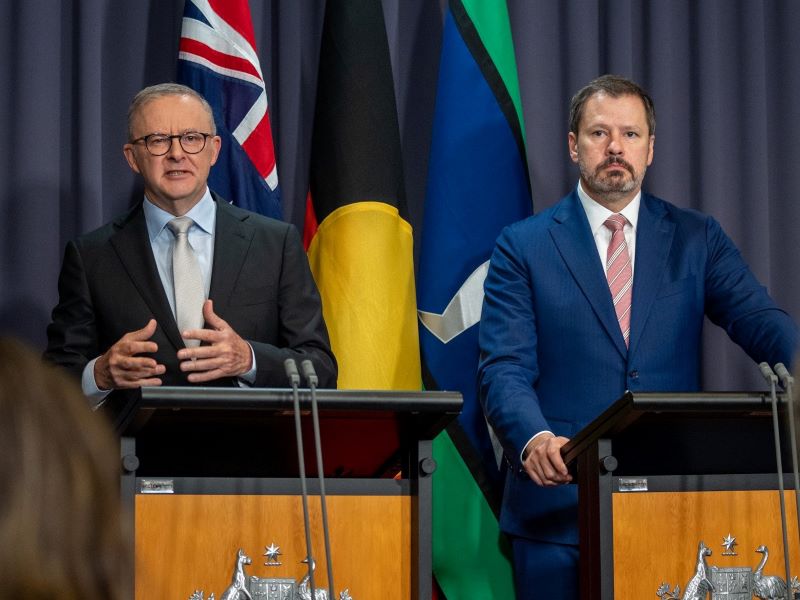The government’s flagship industry policy passed the Parliament on Wednesday, locking in a $15 billion manufacturing fund Anthony Albanese says will deliver both sovereign capabilities as well as an investment return for taxpayers.
The returns generated by the National Reconstruction Fund (NRF) will mean it can continue to invest into manufacturing projects well beyond the initial six-year, $15 billion allocation, the Prime Minister said.
He downplayed concerns the NRF would struggle to compete with larger programs of other national governments, like America’s $418 billion industrial policy, but acknowledged there was a risk that capital would be “sucked to the United States” if the NRF were not put in place.
“This legislation will support Australian innovation and Australian industry,” Mr Albanese said.

The NRF Corporation bill passed Parliament on Wednesday after negotiations in the Senate saw 20 amendment sheets proposed. The government secured Senate cross bench support by agreeing to some changes that go to the size, term, composition and governance of the National Reconstruction Fund board which will control the money.
The Opposition did not support the fund, claiming it would not solve more pressing manufacturing problems, such as the impact of higher energy prices.
The bill returned to the government-controlled House of Representatives on Wednesday, where the Senate amendments were quickly agreed to.
“This is a big day,” Industry minister Ed Husic said.
“This is a big deal. And it’s a big day for Australian industry and for Australian jobs. From our outer suburbs through to the regions we want to create good secure work for Australians and being able to rebuild Australian manufacturing.
“It’s time for us to get up off the mat.”
Mr Husic and the Albanese government campaigned on the $15 billion NRF by highlighting Australia’s slide down economic complexity and manufacturing self-sufficiency rankings – 91st in the world and dead last in the OECD, respectively.
“We do export a lot,” Mr Husic said. “And the other thing we export a lot is ideas.
“They go offshore to be developed by someone else where the value add happens overseas, and then we import that back into the country.
“We should be backing our own. This fund – the National Reconstruction Fund – is about Australians backing Australians in terms of pursuing those idea.”
The $15 billion NRF will be administered by an independent board with members appointed by the Industry minister and Finance minister.
Based on yet to be finalised investment mandates and private sector co-investment plans, the NRF will back Australian manufacturing projects with loans, equity investment or guarantees. The projects would need to have the potential to diversify and transform Australia’s industry and economy and be part of the government’s priority areas:
- renewables and low emissions technologies
- medical science
- transport
- value-add in the agriculture, forestry and fisheries sectors
- value-add in resources
- defence capability
- enabling capabilities.
The changes since Labor’s election promise include requiring a consideration of how the investments would create secure jobs and a skilled workforce, and help to meet Australia’s greenhouse gas emission targets.
The NRF Corporation would also now be required to develop policies on environmental, labour, social and governance matters, and how its investments impact First Nations people.
Governance changes also meant an increase in the size of the NRF Corporation board that ultimately approves investments, while its members’ terms have been reduced from five to four years. The first review of the Act has also been brought forward to 2026.
The changes were proposed by Senate crossbenchers or came from consultations with the public and through the Senate committee process.
Mr Husic said the changes had made the bill stronger and exemplified what the public expects its Parliament should do – work together on national challenges.
“We didn’t agree on everything, but we did agree on areas where we could work together,” Mr Husic said.
Greens leader Adam Bandt said the amendments would help protect the legislation from future governments using the NRF for their own agenda.
The party negotiated with the government to include an amendment in the NRF Corporation bill to explicitly prevent the fund from “directly” financing the extraction of coal and natural gas or pipeline infrastructure for natural gas.
The amendments similarly prevent the direct financing of native forest logging.
“If this authority, this entity, is going to stand the test of time and be there to support manufacturing, and not be used as a slush fund by a future minister to bankroll coal and gas projects – like the previous governments sought to do through the Clean Energy Finance Corporation and the Renewable Energy Agency – then we need to put the protections in law,” Mr Bandt said.
“I want to thank the Minister and his office for their engagement on this to ensure that we’re future proofed this piece of important legislation to ensure that public money does not go to coal, gas or to logging and native forests at a time of climate crisis.”
Mr Albanese said the COVID-19 pandemic had exposed Australia’s dependence on global supply chains, just as it had done form many nations, which are now making similar industry development pushes.
The US policy, delivered through its behemoth Inflation Reduction Act stands out for its scale and similar support for areas like critical minerals, technology and clean energy.
The NRF’s first $5 billion will be available from the commencement of the fund, with the remaining funding to be made available at the Ministers’ determination by July 2029.
Mr Albanese said the regenerative NRF – investments will be made to make a return for the fund – meant it could compete with the “powerful” US plan.
“If we don’t compete, we will see capital sucked from Australia to the United States. We need to recognise the opportunities which are here. The opportunities to grow our economy and grow jobs.”
Do you know more? Contact James Riley via Email.

